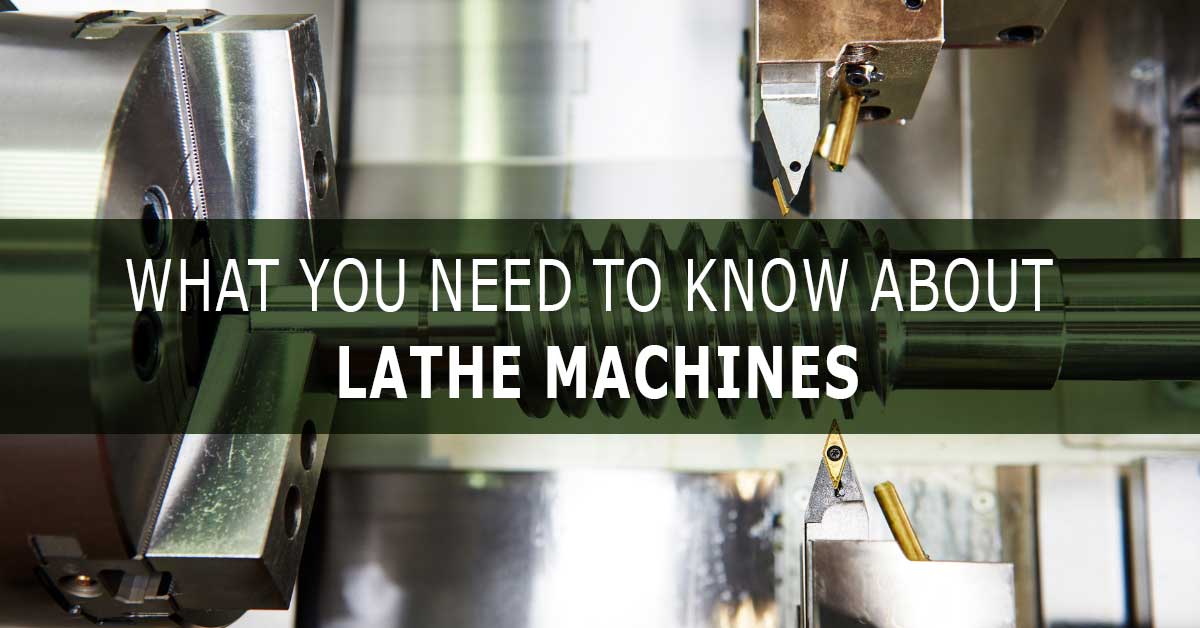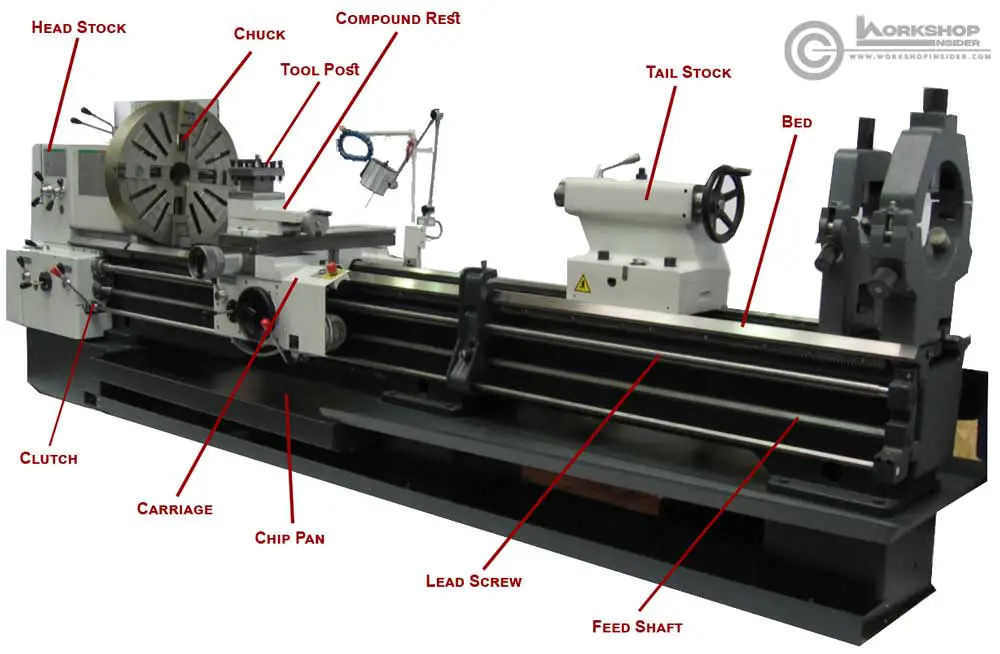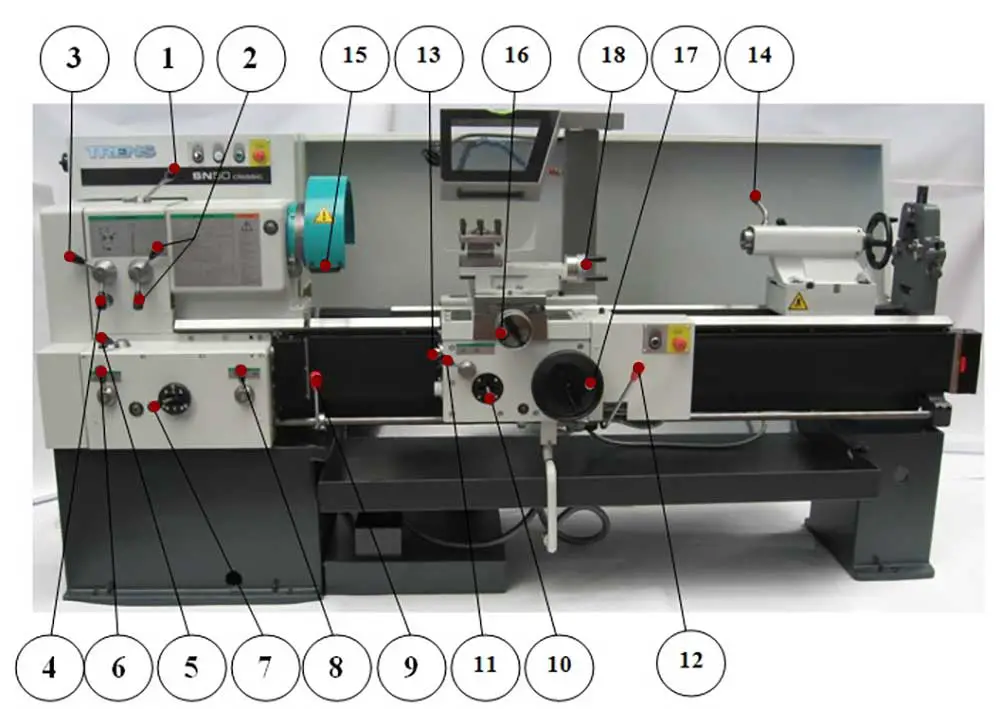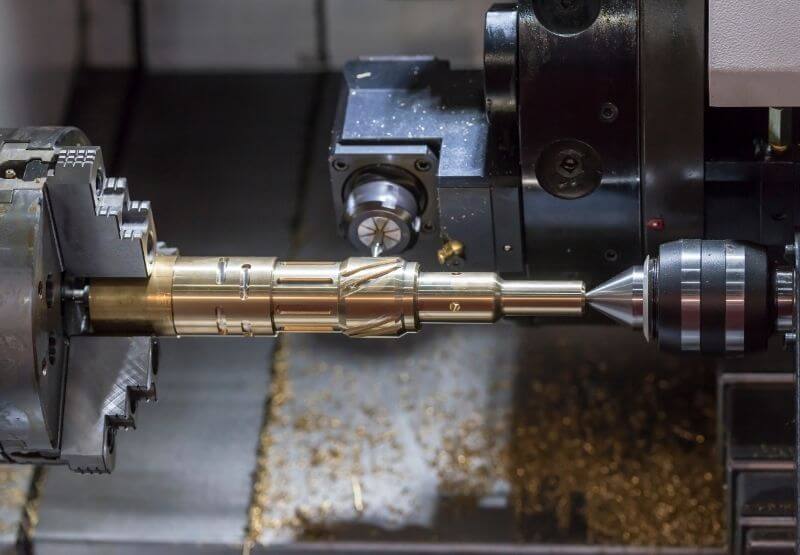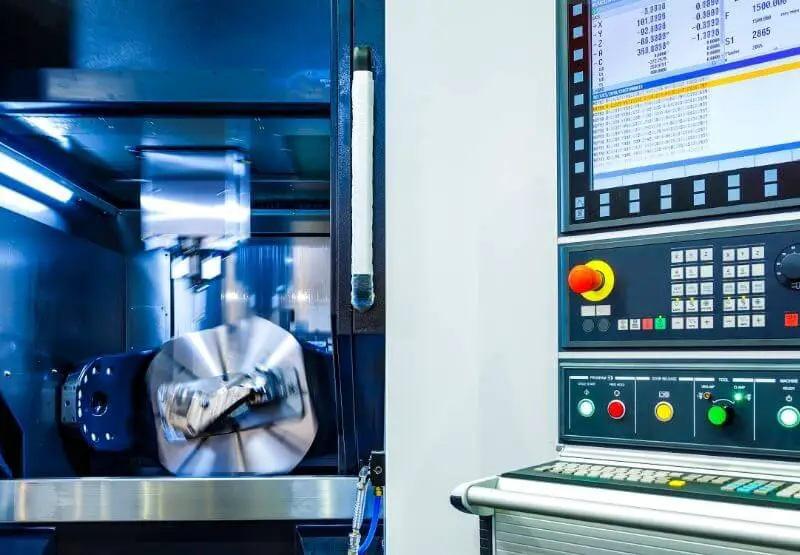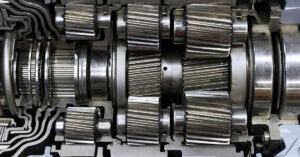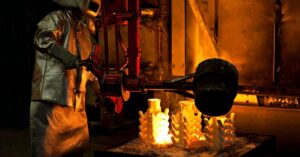Ever since the industrial revolution, mass production and industrial development have been booming to cover the needs for a growing global demand and cope with the fast-paced evolution and technological advancements.
Lathe machines are a vital factor that has been and will continue to be the backbone for advancements and development. This article highlights everything you need to know about lathe machines and how it is integrated with automation.
Lathe machine description
Lathe machines are simple mechanical machines that are designed and utilized to perform multiple machining operations on workpieces of different materials. Machining operations include cutting, facing, drilling, knurling, etc.
The process starts by securing and fixing the workpiece that is to be machined inside the lathe machine. Then, the lathe machine is turned on, and the workpiece starts rotating at controlled speeds against a stationary tool bit (cutting tool). The machining process starts when the rotating workpiece is pressed against the stationary tool bit. This removes material from the workpiece and forms it into new shapes of desired dimensions and curves by removing the unwanted material that needs to be removed to achieve the desired shape and dimensions. Workpieces are usually made of wood or metal.
Lathe machines differ based on the machining technique used and the material being cut. Lathe machine can have features that would allow it to multitask jobs through live tooling capabilities. The applications of lathe vary in size and purpose. Attachments added to lathe machines provide the machine with additional functionality, speciality, and multitasking capabilities. Lathe machines can perform speciality jobs and create parts that are of accurate dimensions and features that would allow them to be used in other machinery serving different purposes.
A lathe machine is a vital machine that is considered one of the most versatile machinery out there. Across history, lathe machines represented one of the main cornerstones for the industrial revolution in different fields, from automotive to medicine to aviation. The following section gives a brief description of the historical significance of lathe machines.
Lathe machine history
Lathe machines are ancient machine tools that are continuously renovated with time. It played and still plays a massive role in the industrial revolution, coping with its fast pace of development. It is considered a pillar of machining tools. An English man called Henry Maudsley was the first to design a screw-cutting machine in 1797.
Historically speaking, a preliminary design of a lathe machine was first used in Ancient Greece. The machine has origins that date back to the 13th and 14th century B.C. in Ancient Greece. The lathe machine had a workbench and a rotating rod, nothing more. However, this invention did pave the way for innovations and the designing of modern lathe machines. Lathe machines are considered the mother of machine tools since they helped develop other machine tools that contributed significantly to the industrial revolution. Hence, lathe machines became invaluable machines for manufacturing factories during the industrial revolution period.
Types of lathe machines
New technologies are constantly introduced, and novel inventions and adjustments of lathe machines are constantly being introduced. This created a variety of lathe machine types with the same operating principles but can be specialized in performing certain jobs with higher accuracy.
The growing demand for products that can perform at high efficiencies and the need for mass production due to the growing global population has boosted innovations and designs of different lathe machines that can perform specialty jobs at higher speeds and precisions. The following is a list that includes some types of lathe machines common among manufacturers and users.
- Center or engine lathe machines.
- Speed lathe machines.
- Toolroom lathe machines.
- Bench lathe machines.
- Capstan lathe machines.
- Automatic lathe machines.
- Computer Numerical Control (CNC) lathe machines.
Lathe machine parts (Components)
In order to know how to operate a lathe machine, you first need to be aware of its different components and parts. As previously mentioned, a lathe machine works by rotating a workpiece against a fixed tool with certain parameters to control. Using different lathe machine attachments can serve different machining purposes such as turning, tapering, screw cutting, form turning, facing, dulling, boring, spinning, grinding, polishing, etc. Different components of lathe machines provide either basic functionality and/or featured specialized functions of machining.
Lathe machine control levers
(1) Spindle speed change lever – The lever is situated on the upper wall of the spindle speed gearbox.
(2) Spindle speed change levers – The levers are situated on the front wall of the spindle speed gearbox on the same axis.
(3) Thread orientation (RH/LH) lever – The lever is situated on the front wall of the spindle speed gearbox.
(4) Transmission ratio lever for carriage and cross slide – The lever is situated on the same axis as a lever #3.
(5) Thread kind (metric/inch) lever – The lever is situated on the upper wall of the thread gearbox.
(6), (7) Feed rate (thread lead levers) – The levers are situated on the front wall of the thread gearbox.
(8) Feed / thread lever – The lever is situated on the front wall of the thread gearbox in the left part.
(9) Spindle control lever – The disengaging lever is mounted on the disengaging rod beside the thread gearbox. It controls only spindle stops.
(10) Feed direction lever – The lever is situated on the front apron wall. When the drive is overloaded, the lever returns to its neutral position.
(11) Nut engagement lever – The lever is situated on the front apron wall.
(12) Clutch lever – START/STOP of spindle run – The lever is situated on the right apron side.
(13) Central lubrication pushbutton – The pushbutton is situated on the left apron wall. By pushing it when the feed rod is running, the guideways of the carriage and cross slide are lubricated.
(14) Quill fixation lever.
(15) Chuck guard.
(16), (17), (18) Fed dial arresters.
Lathe machine specifications and control parameters
Lathe control parameters differ based on the lathe machine being utilized. However, among the main lathe specifications and control parameters that are common between the different lathe machines are the swing, which is the largest diameter distance that can be reached starting from the lathe bed, the bed length in meters, the distance between the tailstock center point and the headstock center point, the available lathe machine horsepower, the range of speeds and number of spindle’s speeds, the lead screw pitch and the weight of the machine in tone state.
Control parameters are one of the essential aspects that are essential for running and operating a lathe machine. If not properly adjusted can lead to problems and malfunctioning of the entire lathe machine. An analogy that comes to my mind when it comes to controlling parameters is an anesthesiologist, who is the person responsible for sedating and drugging a patient who is going to undergo a surgical procedure, who is responsible for adjusting the numbers and amount of medicine and the time the medicine is given to the patient during the procedure. The same happens with the lathe machine operator.
The operator keeps adjusting the feed and different control parameters throughout the machining process to guarantee that the machining process is correctly done and that it will not fail. Different lathe machines have different specifications that make them capable of performing a certain machining operation usually not done by conventional lathe machines, such as working glass workpieces.
Lathe machine operations
Lathe machines are pretty simple to understand and operate. All you need is to understand the basic working principles and safety guidelines, and you are good to go. To start operating the lathe machine, you first need to set up the cutting tool that is going to be used in the machining. The tool post should be moved to the left side of the compound rest. Then inside the tool post, the tool holder should be firmly mounted and tightened. Now is the turn for the cutting tool to be placed inside the tool holder.
Make sure it is securely fastened and that it fits. Now comes the dimensions adjustments. The cutting tool point should be set to the center height. The second main process is mounting the workpiece on the lathe machine. This starts by ensuring that the centers are aligned and that the lathe center points and workpiece center holes are clean. Now, adjust the tailstock spindle to a correct projected length inside the tailstock and place the workpiece end in the lathe machine’s chuck, followed by sliding the tailstock up until the other end of the workpiece is supported and securely in place. After securing the workpiece, installing the cutting tool that is to be utilized in the lathe machine’s tool holder comes into play. Like the previous steps, the tool holder must be clean, and the bolts need to be tight. Insert the cutting tool and securely tighten the bolts to hold the tool in place and prevent it from breaking.
Typically, lathe machines usually come with their handbook manual that guides the operator on the methods and techniques and feed and control parameters that should be used for different purposes. This, in addition to the basic understanding of the lathe machine’s main working principles and safety guidelines, should enable the operator to run the lathe machine successfully with limited guidance.
Examples of lathe machine applications
Lathe machines are critical machines used to make other machines’ components of different dimensions, sizes, features, and specifications. This does not only mean machining mechanical engineering application components like gears and transmission systems but also musical instruments and bowls.
No matter what application the product will be used in, the working concept for the lathe machine is the same. You push a fixed tool against a rotating workpiece to create your own desired components. Lately, with the evolution of Artificial Intelligence and numerical computing technologies, lathe machines can now create extremely complex components that require a high level of detail and precision.
Examples of applications include aerospace, military, scientific research, orthopedics, naval and automotive industries where lathe machines are utilized to produce topologically optimized components with lightweight. Other examples are engine blocks, wheels, and pistons. Mold fabrication is another industry in which accuracy and precision are necessary to achieve excellent surface finishing. Its versatility is the reason behind its vitality. Lathe machines are used in woodturning, metalworking, glasswork, thermal spraying, and metal spinning.
Lathe machines importance and benefits
Lathe machines are highly versatile machines that are used to shape complex components with extreme precision and quality. They are used in a wide range of industries, as stated in the previous section. Hence, lathe machines are vital for manufacturing industries. Lathe machines are involved in various disciplines that include automotive, aviation, medicine, military, etc. Besides, lathe machines are not expected to become obsolete anytime soon or even ever, as they are simple machines that perform almost most of the necessary machining operations.
More and more features are being continuously integrated to lathe to cope with mass production and the upcoming industrial revolutions of artificial intelligence and renewable energy. Later on, in this article, we will be discussing the future of lathe machines and the expected advancements in more detail.
Lathe machines interesting facts
This section discusses some exciting facts about lathe machines. So, let’s start with this one. Did you know that lathe machines that work on wooden workpieces can do up to 1400 revolutions per minute? Certain types of lathes can perform machining processes on glass workpieces besides wood and metal, being the most common workpiece materials. These lathe machines are specific to glass workpieces; however, they still feature a similar machine design to a conventional lathe machine design. This is done by flaming the rotating glass workpiece through a static flame, making it easier to deform its shape without breaking.
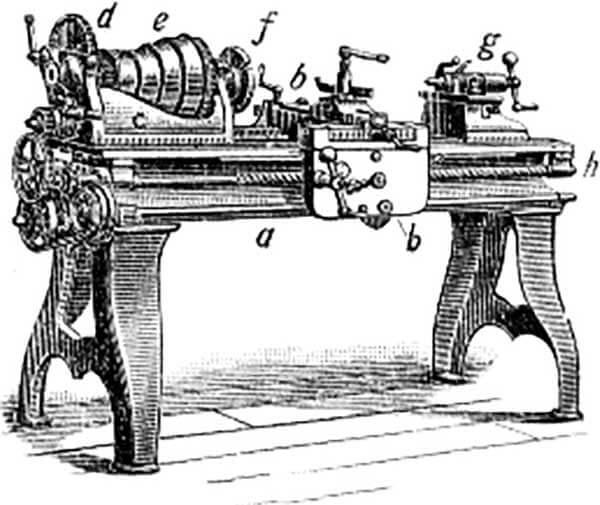
Among the applications of this special type of lathe machine are glass vases, wine glasses, and other 3D glass products. Among the interesting facts about lathe machines is creating uniform shapes using patterns by duplicating lathe machines. This process is also called the copying lathe process.
Computer Numerical Control lathe machining
We have talked about how critical was the invention of lathe machines for the industrial revolution. Now let’s talk about the role it is playing and will continue to play in the current artificial intelligence revolution. What is currently being done is that software-generated 3D models are being used to generate a code that is understood by the lathe machine and based on which the lathe machine starts working independently to machine and create the designed 3D model into a real product.
This process uses software such as SolidWorks to create the 3D model and CAMWorks to generate and design the machining process and steps that are to be followed by the lathe machine to create the desired product automatically without the need for skilled human working hands. Such lathe machines are called CNC machines, which stands for Computer Numerical Control lathe machines.
In these machines, the computer turns a virtual design produced by the CAD software into numbers and coordinates that are used as a reference to guide the lathe machine into the correct exact coordinates creating the desired actual product.
CNC lathe machines allow the user to program the machine to make complex machining activities with high precision and accuracy. Not only does it allow for complex machining activities, but it also does them efficiently in a quick, timely manner as compared to operating lathe machines run by skilled workers.
CNC lathe machines are most commonly used to produce spherical bodies that have certain outside and inside diameters. Similar to conventional lathe machines, CNC lathe machines can work on workpieces of different materials such as metal, wood, and glass, depending on the application. Examples of its machining products include shift knows, hubs, pulleys, bushings, shafts, flywheels, etc. CNC lathe machines are usually multi-axis lathe machines that can work with complex products. This means that the production process is more efficient because no other machines are needed to perform other processes that usually come in a row.
CNC lathe machines usually have powerful axis drives. They also have a Feedback control that monitors the live tool positing for best accuracy and precision. Besides, CNC lathe machines have higher operating speeds. Another significant benefit of a CNC lathe machine is the limited need for supervision. Once the code is unlinked and the CNC lathe machine starts running, it can run for prolonged periods with limited operator supervision. This helps create a completely automated process of machining that is easy to program and control.
Read more: An Overview Of CNC Machining.
Safety considerations
Safety is a significant concern when it comes to operating lathe machines. An unskilled user can seriously injure himself/herself when trying to operate the machine. Errors and mistakes can be catastrophic and fatal. The user is obliged to wear glasses to protect his/her eyes, have short sleeves, and have no ties to avoid the sleeve or tie getting stuck inside the rotating workpiece, causing severe injuries and no rings or bracelet.
The following is a list of regulations and guidelines on operating a lathe machine safely and successfully without causing any injuries and exposing yourself to dangers and life-threatening injuries.
- After use, the chuck key needs to be removed immediately.
- If the chuck still has the chuck key, do not turn the lathe machine on.
- Make sure that the chuck is securely tightened to the lathe machine’s spindle.
- Chips should be cleaned by a brush, not by hand.
- Any necessary adjustments need to be implemented when the machine is turned off, not while it is running.
- To protect your eyes from injury caused by flying chips, goggles should be worn during the entire machining time.
- Before working, you should be sure that all lathe machine components are securely fastened and tight.
- Do not place any tools on the lathe machining table.
- Keep mating surfaces clean and clear of burrs.
- Correct clearance angles should be maintained when using the tool bit.
- In order to avoid the breakage or resonance of the tool bit when using the lathe machine, the tool bit needs to be inserted fully in the tool holder.
- Cooling fluids should be continuously applied during the machining process to prevent morphing.
- Threaded spindles should never be run in reverse.
- Recommended speeds to specific materials need to be maintained and never exceeded to avoid damaging the workpiece and the lathe machine itself.
- The lathe machine should always be off when taking measurements and readings.
- Remove long stringy chips using a pair of pliers.
- Before cleaning, all tools inside the post and tailstock should be removed.
- Never use compressed air to clean the lathe machine.
- Use protective gloves when operating and cleaning the machine to avoid cutting your fingers with sharp tools or workpieces.
- Stay alert to not getting into an autopilot mode when doing repetitive machining tasks, because that is when mistakes happen.
- Read and study well-documented lathe machine safety guidelines.
- Ensure that all tools are sharp. Using damaged and dull tools is not only ineffective but also dangerous.
- Seek guidance in matters that you are not sure of, or don’t have enough experience to deal with.
Conclusion
In conclusion, lathe machines are and will continue to be a pillar of manufacturing and industrial development. Innovations will continue. The foreseen future for lathe machines is lathe machines getting fully automated and completely integrated with the current renewable energy and artificial intelligence industrial revolution.
Features will continue to be added to the lathe machines. Perhaps a wider variety of workpieces’ materials can be machined using more advanced lathe machines. For the time being, if you are passionate about using lathe machines and want to create your own shapes and features. Then, depending on the complexity of the desired expected bodies, a more advanced lathe machine with multiple working axes should be used.
It is also necessary to abide by the lathe machine’s safety regulations and guidelines to avoid injuring yourself or harming others. Despite being simple in their working concept, lathe machines are highly vital for the manufacturing industry upon which many processes and products are based.
References

